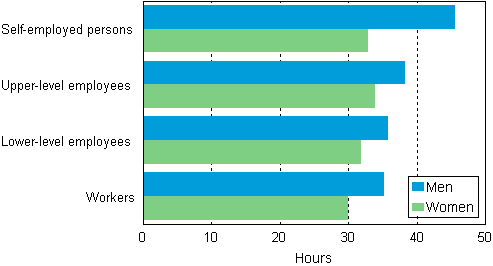Published: 16 April 2014
One-half of working weeks are five days long
A five-day working week is the most common in Finland: one-half of employed persons had worked on five days a week. The working week of self-employed persons was longer than five days more often than that of wage and salary earners. Nearly one-third of self-employed persons worked on all days of the week. These data appear from the week diaries concerning gainful work collected in connection with the Time Use Survey 2009 to 2010.
Distribution of employed persons’ working days in the survey week by gender in 2009 to 2010, per cent

Men’s working weeks are longer than women’s. The length of employed men's working week was 38 hours, on average, while women worked in gainful employment 32 hours, on average.
The average length of employed persons’ working week by socio-economic group and gender in 2009 to 2010, hours

Over one-half of employed persons had worked only during daytime over the survey week. Two-fifths of employed persons had done evening work after 6 pm on some day of the week. Good one-tenth of employed persons had worked during the night. The share of those having done only evening or night work during the survey week was almost non-existent.
The customary "normal" working week, when one works full-day from Monday to Friday during daytime, is fairly rare. Approximately 30 per cent of wage and salary earners had such a working week over the survey week. The working week was rarely "normal" among self-employed persons.
The data in the week diary describe only those weeks on which one worked at least on one day. In addition to paid work, gainful work was regarded as work done as self-employed and in the family company. Included is secondary work done in addition to work done at the workplace and work brought home. Respondents were also requested to record occasional and minor work on the form if it was gainful employment. In contrast, lunch hours or other unpaid breaks and travel between home and work were not counted in work.
Source: Time Use Survey 2009, Statistics Finland
Inquiries: Hannu Pääkkönen (09) 1734 3229 , Riitta Hanifi (09) 1734 2946, ajankaytto@stat.fi
Director in charge: Riitta Harala
- Tables
-
Tables in databases
Pick the data you need into tables, view the data as graphs, or download the data for your use.
Updated 16.4.2014
Official Statistics of Finland (OSF):
Time use [e-publication].
Structure of working week 2009. Helsinki: Statistics Finland [referred: 19.4.2025].
Access method: http://stat.fi/til/akay/2009/07/akay_2009_07_2014-04-16_tie_001_en.html

